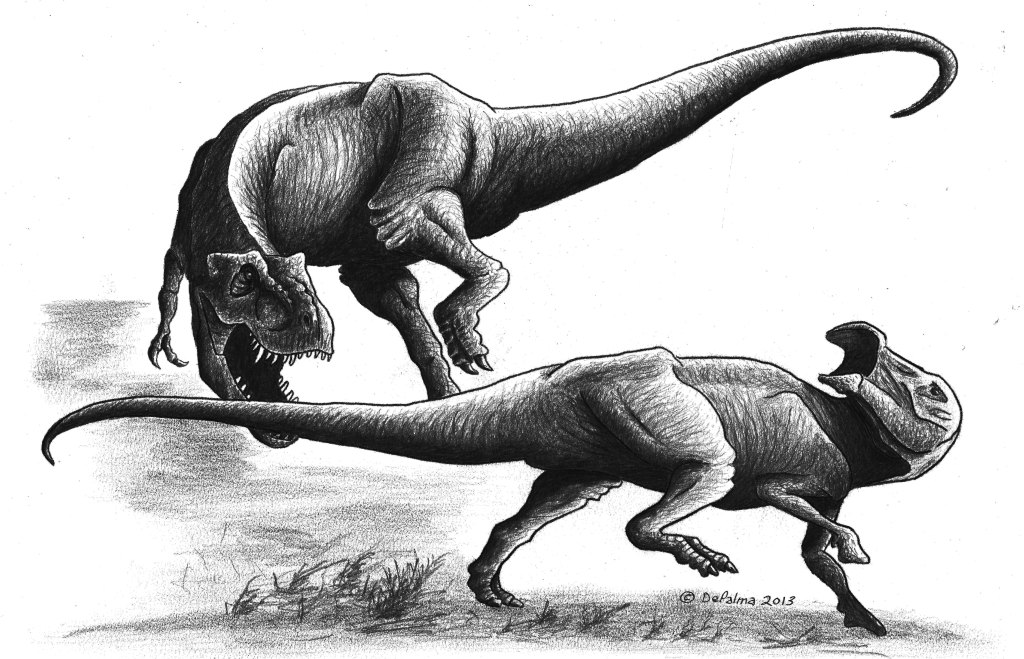
As most anyone who went through the "dinosaur phase" in childhood already guessed Tyrannosaurus rex was a fearsome predator.
A plant-eating dinosaur found with a Tyrannosaurus rex tooth lodged in its the tail of a plant-eating dinosaur has confirmed what scientists long suspected: T. rex was a predator.
The tooth was discovered in the tail of a hadrosaur that lived about 66 million years ago.
"It's the Holy Grail for a paleontologist," said study co-author David Burnham, a paleontologist at the University of Kansas. "Not only was the tooth broken off, but the tail had healed around it. That means that Tyrannosaurus rex attacked that other dinosaur." [Image Gallery: See the T. rex bite wound ]
The findings were published today (July 15) in the journal Proceedings of the National Academy of Sciences.
Circumstantial evidence
Although T. rex has been portrayed as the deadliest dino predator, the case for predation wasn't airtight. Even though stomach remains, a fearsome bite and body plan all suggested the imposing dinosaur attacked and ate other prey, some paleontologists proposed that T. rex was a scavenger, feasting on already dead animals but not killing its prey itself.
Sign up for the Live Science daily newsletter now
Get the world’s most fascinating discoveries delivered straight to your inbox.
A few other herbivore fossils had been found with traces of T. rex bite wounds, but the evidence wasn't conclusive.
Burnham and his colleagues were excavating in the Hell Creek formation in South Dakota. During the Cretaceous Period, the area was a vast network of forested rivers, and the formation now contains myriad fossils of dinosaurs and small mammals from the period.
'Beyond a reasonable doubt'
Burnham's graduate student, Robert DePalma, uncovered two fused vertebrae from the tail of a hadrosaur, likely Edmontosaurus annectens, a plant eater that munched on pine needles using scissorlike teeth.
Lodged inside the vertebrae was part of a tooth, and the area around it showed signs of healing. When the team analyzed the serrations on the tooth, they confirmed it belonged to a T. rex.
"We were able to establish beyond a reasonable doubt that that is a T.rex tooth," Burnham told LiveScience.
The T. rex likely attacked the hadrosaur, but the herbivore was able to escape, Burnham said. The healing over the tooth indicates that the hadrosaur lived awhile after the attack.
The new findings prove that the iconic dinosaur preyed on hadrosaurs.
"This is the first time we have physical evidence, and without physical evidence for predation, people always said, 'Oh yeah, T.rex could have been a scavenger,'" Burnham said.
Follow Tia Ghose on Twitter and Google+. Follow LiveScience@livescience,Facebook &Google+. Original article on LiveScience.com.

Tia is the managing editor and was previously a senior writer for Live Science. Her work has appeared in Scientific American, Wired.com and other outlets. She holds a master's degree in bioengineering from the University of Washington, a graduate certificate in science writing from UC Santa Cruz and a bachelor's degree in mechanical engineering from the University of Texas at Austin. Tia was part of a team at the Milwaukee Journal Sentinel that published the Empty Cradles series on preterm births, which won multiple awards, including the 2012 Casey Medal for Meritorious Journalism.









